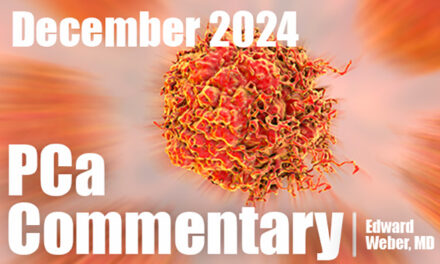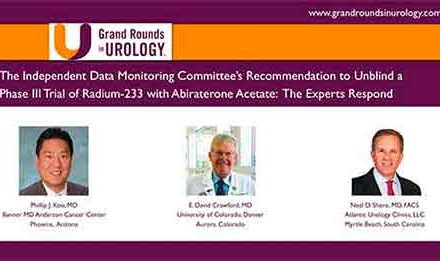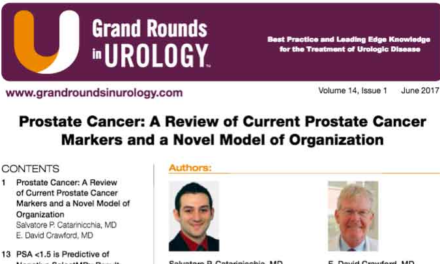Presentation Overview and Statement of Need
Patterns of care in prostate cancer (PCa) have changed tremendously in the past 20 years, altering the way patients with this tumor present and how they are evaluated before and after diagnosis. With the use of new and combined treatments, the frequency and variety of complications have differed from those previously reported. Advances have been made in PCa imaging, biopsy methodology, in understanding causative factors and disease, in treatment-related quality of life, and in predicting the behavior of individual tumors using risk strata. Despite these advances, no consensus has emerged regarding the optimal treatment for the most common patient with PCa.
A number of educational gaps between recent research in PCa and its integration into professional practice at the international, national, and community levels that were presented and discussed at the 24th annual International Prostate Cancer Update (IPCU 24), held February 19-22, 2014 in Vail, Colorado. The IPCU 24 educational planning committee identified:
• Current best practices in prevention and screening of prostate cancer
• Promising therapies, issues, and economic concerns in the treatment of prostate cancer
• Role of newly available therapies in 2014
• Emerging treatment options for advanced and castration-resistant PCa
There is a need for oncologists, urologists, and nurses to understand the rationale behind targeted therapy for the treatment of advanced PCa, and how trial entry could improve the efficacy of drugs and decrease the toxicity.
This activity seeks to educate urologists and other healthcare professionals about the latest advances in the prevention, screening, and treatment of PCa, and is a highlights of selected presentation topics presented in February 2014 in Vail, Colorado.
Presentation:
Keywords: prostate cancer, blood tests, urine tests, SNP, gene expression assays, MRI, biomarkers, AUA Guidelines, targeted biopsy, standard biopsy, template biopsy, testosterone replacement, adjuvant radiotherapy, salvage radiotherapy, radiation toxicity, PSA recurrence, molecular targeting, PSMA imaging agents, focal therapy, androgen deprivation therapy, GnRH antagonists, radiosurgery, CyberKnife, optical spectroscopy, PET imaging, salvage cryotherapy, salvage prostatectomy, ADT, novel hormonal therapies, radiopharmaceuticals, mCRPC
How to cite: Crawford, E. David, Et Al. “Highlights from the 24th International Prostate Cancer Update.” Grand Rounds in Urology. June 1, 2014. Accessed Jul 2025. https://grandroundsinurology.com/highlights-24th-international-prostate-cancer-update/.
Faculty
Medical Editor:
E. David Crawford, MD
University of Colorado Denver
Aurora, Colorado
Faculty:
Alan W. Partin, MD, PhD
Johns Hopkins Medical Institutions
Baltimore, Maryland
M. Scott Lucia, MD
University of Colorado Denver
Aurora, Colorado
Peter F. A. Mulders, MD, PhD
Radboud University Medical Center
Nijmegen, The Netherlands
Daniel P. Mulders, MD
Yale Cancer Center
New Haven, Connecticut
Neal D. Shore, MD
Atlantic Urology Clinics, LLC
Myrtle Beach, South Carolina
Leonard G. Gomella, MD
Thomas Jefferson University
Philadelphia, Pennsylvania
References
1. Catalona WJ, Partin AW, Sanda MG, et al. A multicenter study of [-2]pro-prostate specific antigen combined with prostate specific antigen and free prostate specific antigen for prostate cancer detection in the 2.0 to 10.0 ng/ml prostate specific antigen range. J Urol. 2011;185(5):1650-1655. http://www.ncbi.nlm.nih.gov/pubmed/21419439
2. Lughezzani G, Lazzeri M, Larcher A, et al. Development and internal validation of a Prostate Health Index based nomogram for predicting prostate cancer at extended biopsy. J Urol. 2012;188(4):1144-1150. http://www.ncbi.nlm.nih.gov/pubmed/22901589
3. Lughezzani G, Lazzeri M, Haese A, et al. Multicenter European External Validation of a Prostate Health Index-based Nomogram for Predicting Prostate Cancer at Extended Biopsy. Eur Urol. 2013. http://www.ncbi.nlm.nih.gov/pubmed/ 24361258 [Epub ahead of print]
4. Deras IL, Aubin SM, Blase A, et al. PCA3: a molecular urine assay for predicting prostate biopsy outcome. J Urol. 2008;179(4):1587-1592. http://www.ncbi.nlm.nih.gov/pubmed/18295257
5. Wei J, Sanda M, Thompson I, et al. Use of PCA3 urinary assay to supplement PSA-based prostate cancer screening. J Clin Oncol. 2014. [InPress]
6. Tomlins SA, Laxman B, Dhanasekaran SM, et al. Distinct classes of chromosomal rearrangements create oncogenic ETS gene fusions in prostate cancer. Nature. 2007;448(7153):595-599. http://www.ncbi.nlm.nih.gov/pubmed/17671502
7. Day JR, Groskopf J, Jones LA, et al. Urinary PCA3 and TMPRSS2:ERG help predict biopsy outcome prior to initial prostate biopsy using a risk group analysis. European Association of Urology (EAU) 28th Annual Congress. March 17, 2013; Milan, Italy. Abstract 1045.
8. Vickers AJ, Cronin AM, Aus G, et al. A panel of kallikrein markers can reduce unnecessary biopsy for prostate cancer: data from the European Randomized Study of Prostate Cancer Screening in Göteborg, Sweden. BMC Med. 2008;6:19. http://www.ncbi.nlm.nih.gov/pubmed/18611265
9. Vickers AJ, Cronin AM, Roobol MS, et al. Reducing unnecessary biopsy during prostate cancer screening using a four-kallikrein panel: an independent replication. J Clin Oncol. 2010;28(15):2493-2498. http://www.ncbi.nlm.nih.gov/pubmed/20421547
10. Vickers AJ, Gupta A, Savage CJ, et al. A panel of kallikrein marker predicts prostate cancer in a large, population-based cohort followed for 15 years without screening. Cancer Epidemiol Biomarkers Prev. 2011;20(2):255-261.
11. Amundadottir LT, Sulem P, Gudmundsson J, et al. A common variant associated with prostate cancer in European and African populations. Nat Genet. 2006;38(6):652-658. http://www.ncbi.nlm.nih.gov/pubmed/16682969
12. Zheng SL, Sun J, Wiklund F, et al. Cumulative association of five genetic variants with prostate cancer. N Engl J Med. 2008;358(9):910-919. http://www.ncbi.nlm.nih.gov/pubmed/18199855
13. Aly M, Wiklund F, Xu J, et al. Polygenic risk score improves prostate cancer risk prediction: results from the Stockholm-1 cohort study. Eur Urol. 2011;60(1):21-28. http://www.ncbi.nlm.nih.gov/pubmed/21295399
14. Gudmundsson J, Sulem P, Rafnar T, et al. Common sequence variants on 2p15 and Xp11.22 confer susceptibility to prostate cancer. Nat Genet. 2008;40(3):281-283. http://www.ncbi.nlm.nih.gov/pubmed/18264098
15. Kader AK, Sun J, Reck BH, et al. Potential impact of adding genetic markers to clinical parameters in predicting prostate biopsy outcomes in men following an initial negative biopsy: findings from the REDUCE trial. Eur Urol. 2012;62(6):953-961.
16. McKiernan J, Saltzstein D, Cochran J, et al. Urinary exosomes/microvesicles as a non-invasive platform for prostate cancer analysis. 2013 American Urological Association (AUA) Annual Meeting. May 4-8, 2013; San Diego, CA. Abstract 2053.
17. Taneja SS, Bjurlin MA, Carter HB, et al. Optimal techniques of prostate biopsy and specimen handling. American Urological Association (AUA) White Paper. 2013.
18. Shen F, Shinohara K, Kumar D, et al. Three-dimensional sonography with needle tracking: role in diagnosis and treatment of prostate cancer. J Ultrasound Med. 2008;27(6):895-905. http://www.ncbi.nlm.nih.gov/pubmed/18499849
19. Stewart GD, Van Neste L, Delvenne P, et al. Clinical utility of an epigenetic assay to detect occult prostate cancer in histopathologically negative biopsies: results of the MATLOC study. J Urol. 2013;189(3):1110-1116. http://www.ncbi.nlm.nih.gov/pubmed/22999998
20. Partin AW, Van Neste L, Klein EA, et al. Clinical validation of an epigenetic assay to predict negative histopathological results in repeat prostate biopsies. J Urol. 2014. http://www.ncbi.nlm.nih.gov/pubmed/24747657 [Epub ahead of print]
21. Cuzick J, Swanson GP, Fisher G, et al. Prognostic value of an RNA expression signature derived from cell cycle proliferation genes in patients with prostate cancer: a retrospective study. Lancet Oncol. 2011;12(3):245-255.
22. Erho N, Crisan A, Vergara IA, et al. Discovery and validation of a prostate cancer genomic classifier that predicts early metastasis following radical prostatectomy. PLoS One. 2013;8(6):e66855. http://www.ncbi.nlm.nih.gov/pubmed/23826159
23. Karnes RJ, Bergstralh EJ, Davicioni E, et al. Validation of a genomic classifier that predicts metastasis following radical prostatectomy in an at risk patient population. J Urol. 2013;190(6):2047-2053. http://www.ncbi.nlm.nih.gov/pubmed/23770138
24. Ross AE, Feng FY, Ghadessi M, et al. A genomic classifier predicting metastatic disease progression in men with biochemical recurrence after prostatectomy. Prostate Cancer Prostatic Dis. 2014;17(1):64-69.
25. Cuzick J, Berney DM, Fisher G, et al. Prognostic value of a cell cycle progression signature for prostate cancer death in a conservatively managed needle biopsy cohort. Br J Cancer. 2012;106(6):1095-1099. http://www.ncbi.nlm.nih.gov/pubmed/22361632
26. Cooperberg MR, Simko J, Falzarano SM, et al. Development and validation of the biopsy-based genomic prostrate score (GPS) as a predictor of high grade or extracapsular prostate cancer to improve patient selection for active surveillance. 2013 American Urological Association (AUA) Annual Meeting. May 2013; San Diego, CA. Abstract 2131.
27. Irshad S, Bansal M, Castillo-Martin M, et al. A molecular signature predictive of indolent prostate cancer. Sci Transl Med. 2013;5(202):202ra122. http://www.ncbi.nlm.nih.gov/pubmed/24027026
28. Hambrock T et al. Thirty-two-channel coil 3T magnetic resonance-guided biopsies of prostate tumor suspicious regions identified on multimodality 3T magnetic resonance imaging: technique and feasibility. Invest Radiol. 2008;43(10):686-694.
29. Hambrock T et al. Magnetic resonance imaging guided prostate biopsy in men with repeat negative biopsies and increased prostate specific antigen. J Urol. 2010;183(2):520-527. http://www.ncbi.nlm.nih.gov/pubmed/20006859
30. Leyten G, Barentz J, Mulders P, Schalken J. Value of PCA3 to Predict Biopsy Outcome and Its Potential Role in Selecting Patients for Multiparametric MRI. Int J Mol Sci. 2013;14(6):11347-11355. http://www.ncbi.nlm.nih.gov/pubmed/23759986
31. Busetto GM, De Berardinis E, Sciarra A, et al. Prostate cancer gene 3 and multiparametric magnetic resonance can reduce unnecessary biopsies: decision curve analysis to evaluate predictive models. Urology. 2013;82(6):1355-1360.
32. Sciarra A Panebianco V, Cattarino S, et al. Multiparametric magnetic resonance imaging of the prostate can improve the predictive value of the urinary prostate cancer antigen 3 test in patients with elevated prostate-specific antigen levels and a previous negative biopsy. BJU Int. 2012;110(11):1661-1665. http://www.ncbi.nlm.nih.gov/pubmed/22564540
33. Harouaka R, Kang Z, Zheng SY, Cao L. Circulating tumor cells: advances in isolation and analysis, and challenges for clinical applications. Pharmacol Ther. 2014;141(2):209-221 http://www.ncbi.nlm.nih.gov/pubmed/24134902
34. CellSearch® Circulating Tumor Cell Test. Janssen Diagnostics, LLC. Raritan, NJ.
35. de Bono JS, Scher HI, Montgomery RB, et al. Circulating tumor cells predict survival benefit from treatment in metastatic castration-resistant prostate cancer. Clin Cancer Res. 2008;14(19):6302-6309. http://www.ncbi.nlm.nih.gov/pubmed/18829513
36. Scher HI, Jia X, de Bono JS, et al. Circulating tumour cells as prognostic markers in progressive, castration-resistant prostate cancer: a reanalysis of IMMC38 trial data. Lancet Oncol. 2009;10(3):233-239. http://www.ncbi.nlm.nih.gov/pubmed/19213602
37. Goodman OB Jr, Symanowski JT, Loudyi A, Fink LM, Ward DC, Vogelzang NJ. Circulating tumor cells as a predictive biomarker in patients with hormone-sensitive prostate cancer. Clin Genitourin Cancer. 2011;9(1):31-38. http://www.ncbi.nlm.nih.gov/pubmed/21705286
38. Miyamoto DT, Lee RJ, Stott SL, et al. Androgen receptor signaling in circulating tumor cells as a marker of hormonally responsive prostate cancer. Cancer Discov. 2012;2(11):995-1003. http://www.ncbi.nlm.nih.gov/pubmed/23093251
39. Lilleby W, Stensvold A, Mills IG, Nesland JM. Disseminated tumor cells and their prognostic significance in nonmetastatic prostate cancer patients. Int J Cancer. 2013;133(1):149-155.
40. Petrylak D, et al. A phase III study to evaluate the efficacy and safety of docetaxel and prednisone with or without lenalidomide in patients with castrate-resistant prostate cancer: the MAINSAIL Trial. 2012 European Society of Medical Oncology Annual Meeting. September 28-October 2, 2012; Vienna, Austria. Abstract LBA24.
41. Quinn DI, Tangen CM, Hussain M, et al. Docetaxel and atrasentan versus docetaxel and placebo for men with advanced castration-resistant prostate cancer (SWOG S0421): a randomised phase 3 trial. Lancet Oncol. 2013;14(9):893-900. http://www.ncbi.nlm.nih.gov/pubmed/23871417
42. Cook, RJ, Coleman, R, Brown, J et al. Markers of bone metabolism and survival in men with hormone-refractory metastatic prostate cancer. Clin Cancer Res. 2006;12(11 Pt 1):3361–3367. http://www.ncbi.nlm.nih.gov/pubmed/16740758
43. Lipton A, Cook R, Saad F, et al. Normalization of bone markers is associated with improved survival in patients with bone metastases from solid tumors and elevated bone resorption receiving zoledronic acid. Cancer. 2008;113(1):193-201. http://www.ncbi.nlm.nih.gov/pubmed/18459173
44. Lara PN, Ely B, Quinn DI, et al. WOG 0421: Prognostic and predictive value of bone metabolism biomarkers in castration-resistant prostate cancer patients with skeletal metastases treated with docetaxel with or without atrasentan. 2012 American Society of Clinical Oncology Annual Meeting. June 1-5, 2012; Chicago, IL. Abstract 4547.
45. Steinberg J, Oyasu R, Lang S, et al. Intracellular levels of SGP-2 (clusterin) correlate with tumor grade in prostate cancer. Clin Cancer Res. 1997;3(10):1707-1711 http://www.ncbi.nlm.nih.gov/pubmed/9815554
46. July LV, Akbari M, Zellweger T, Jones EC, Goldenberg SL, Gleave ME. Clusterin expression is significantly enhanced in prostate cancer cells following androgen withdrawal therapy. Prostate. 2002;50(3):179-188. http://www.ncbi.nlm.nih.gov/pubmed/11813210
47. Miyake H, Chi KN, Gleave ME. Antisense TRPM-2 oligodeoxynucleotides chemosensitize human androgen-independent PC-3 prostate cancer cells both in vitro and in vivo. Clin Cancer Res. 2000;6(5):1655-1663. http://www.ncbi.nlm.nih.gov/pubmed/10815883
48. Zellweger T, Chi K, Miyake H, et al. Enhanced radiation sensitivity in prostate cancer by inhibition of the cell survival protein clusterin. Clin Cancer Res. 2002;8(10):3276-3284. http://www.ncbi.nlm.nih.gov/pubmed/12374699
49. Chi KN, Siu LL, Hirte H, et al. A phase I study of OGX-011, a 2’-methoxyethyl phosphorothioate antisense to clusterin, in combination with docetaxel in patients with advanced cancer. Clin Cancer Res. 2008;14(3):833-839. http://www.ncbi.nlm.nih.gov/pubmed/18245546
50. Chi KN, Hotte SJ, Yu EY, et al. Randomized phase II study of docetaxel and prednisone with or without OGX-011 in patients with metastatic castration-resistant prostate cancer. J Clin Oncol. 2010;28(27):4247-4254. http://www.ncbi.nlm.nih.gov/pubmed/20733135
51. de Bono JS, Oudard S, Ozguroglu M, et al. Prednisone plus cabazitaxel or mitoxantrone for metastatic castration-resistant prostate cancer progressing after docetaxel treatment: a randomised open-label trial. Lancet. 2010;376(9747):1147-1154. http://www.ncbi.nlm.nih.gov/pubmed/20888992
52. Zhu ML, Horbinski CM, Garzotto M, Qian DZ, Beer TM, Kyprianou N. Tubulin-targeting chemotherapy impairs androgen receptor activity in prostate cancer. Cancer Res. 2010;70(20):7992-8002. http://www.ncbi.nlm.nih.gov/pubmed/20807808
53. Mezynski J, Pezaro C, Bianchini D, et al. Antitumour activity of docetaxel following treatment with the CYP17A1 inhibitor abiraterone: clinical evidence for cross-resistance? Ann Oncol. 2012;23(11):2943-2947. http://www.ncbi.nlm.nih.gov/pubmed/22771826
54. Tannock IF, de Wit R, Berry WR, et al. Docetaxel plus prednisone or mitoxantrone plus prednisone for advanced prostate cancer. N Engl J Med. 2004;351(15):1502-1512 http://www.ncbi.nlm.nih.gov/pubmed/15470213.
55. National Comprehensive Cancer Network (NCCN). NCCN Clinical Practice Guidelines in Oncology–Prostate Cancer. V1. 2014. Available at http://www.nccn.org. Accessed Jan 6, 2014.
56. Drake CG, Sharma P, Gerritsen W. Metastatic castration-resistant prostate cancer: new therapies, novel combination strategies and implications for immunotherapy. Oncogene. 2013. http://www.ncbi.nlm.nih.gov/pubmed/24276248 [Epub ahead of print].
57. Kantoff PW, Higano CS, Shore ND, et al. Sipuleucel-T immunotherapy for castration-resistant prostate cancer. N Engl J Med. 2010;363(5):411-422. http://www.ncbi.nlm.nih.gov/pubmed/20818862
58. Sheikh NA, Petrylak D, Kantoff PW, et al. Sipuleucel-T immune parameters correlate with survival: an analysis of the randomized phase 3 clinical trials in men with castration-resistant prostate cancer. Cancer Immunol Immunother. 2012;62(1):137-47.
59. Fong L, Weinberg VK, Chan SE, et al. Neoadjuvant sipuleucel-T in localized prostate cancer: effects on immune cells within the prostate tumor microenvironment. 2012 American Society of Clinical Oncology Annual Meeting. June 1-5, 2012; Chicago, IL. Abstract 2564.
60. Schellhammer PF, Chodak G, Whitmore JB, Sims R, Frohlich MW, Kantoff PW. Lower baseline prostate-specific antigen is associated with a greater overall survival benefit from sipuleucel-T in the Immunotherapy for Prostate Adenocarcinoma Treatment (IMPACT) trial. Urology. 2013;81(6):1297-1302.
61. Gulley JL. Therapeutic vaccines: the ultimate personalized therapy? Hum Vaccin Immunother. 2013;9(1):219-221.http://www.ncbi.nlm.nih.gov/pubmed/22995839
62. Drake CG, Fan LQ, Thakurta DG, et al. Antigen spread and survival with sipuleucel-T in patients with advanced prostate cancer. 2014 American Society of Clinical Oncology Genitourinary Cancers Symposium. January 30-February 1, 2014; Orlando, FL. Abstract 88.
63. Kantoff PW, Schuetz TJ, Blumenstein BA, et al. Overall survival analysis of a phase II randomized controlled trial of a Poxviral-based PSA-targeted immunotherapy in metastatic castration-resistant prostate cancer. J Clin Oncol. 2010;28(7):1099-1105.
64. Gerritsen WR. CA184-043: A randomized, multicenter, double-blind phase 3 trial comparing overall survival in patients with post-docetaxel castration-resistant prostate cancer and bone metastases treated with ipilimumab vs placebo, each following single-dose radiotherapy. 2013 European Cancer Congress. September 27-Ocgrandroundseducation.com 23 October 1, 2013; Amsterdam, Netherlands. Abstract 2850
65. Drake CG. Prostate cancer as a model for tumour immunotherapy. Nat Rev Immunol. 2010;10(8):580-593. http://www.ncbi.nlm.nih.gov/pubmed/20651745
66. Gulley JL, Drake CG. Immunotherapy for prostate cancer: recent advances, lessons learned, and areas for further research. Clin Cancer Res. 2011;17(12):3884-3891. http://www.ncbi.nlm.nih.gov/pubmed/21680544
67. Kirkwood JM, Ferrone S, et al. Immunotherapy of cancer in 2012. CA Cancer J Clin. 2012;62(5):309-335. http://www.ncbi.nlm.nih.gov/pubmed/22576456
68. Mellman I, Coukos G, Dranoff G. Cancer immunotherapy comes of age. Nature. 2011;480(7378):480-489. http://www.ncbi.nlm.nih.gov/pubmed/22193102
69. Hofland J, van Weerden WM, Dits NFJ, et al. Evidence of limited contributions for intratumoral steroidogenesis in prostate cancer. Cancer Res. 2010;70(3):1256-1264. http://www.ncbi.nlm.nih.gov/pubmed/20086173
70. Chen Y, Clegg NJ, Scher HI. Antiandrogens and androgen depleting therapies in prostate cancer: novel agents for an established target. Lancet Oncol. 2009;10(10):981-991. http://www.ncbi.nlm.nih.gov/pubmed/21859989
71. Montgomery RB, Mostaghel EA, Vessella R, et al. Maintenance of intratumoral androgens in metastatic prostate cancer: a mechanism of castration-resistant tumor growth. Cancer Res. 2008;68(11):4447-4454. http://www.ncbi.nlm.nih.gov/pubmed/18519708
72. Stanbrough M, Bubley GJ, Ross K, et al. Increased expression of genes converting adrenal androgens to testosterone in androgen-independent prostate cancer. Cancer Res. 2006;66(5):2815-2825. http://www.ncbi.nlm.nih.gov/pubmed/16510604
73. Holzberlein J, Lal P, LaTulippe E, et al. Gene expression analysis of human prostate carcinoma during hormonal therapy identifies androgen-responsive genes and mechanisms of therapy resistance. Am J Pathol. 2004;164(1):217-227. http://www.ncbi.nlm.nih.gov/pubmed/14695335
74. Friedlander TW, Roy R, Tomlins SA, et al. Common structural and epigenetic changes in the genome of castration-resistant prostate cancer. Cancer Res. 2012;72(3):616-625. http://www.ncbi.nlm.nih.gov/pubmed/22158653
75. Pienta KJ, Bradley D. Mechanisms underlying the development of androgen-independent prostate cancer. Clin Cancer Res. 2006;12(6):1665–1671. http://www.ncbi.nlm.nih.gov/pubmed/16551847
76. Chen CD, Welsbie DS, Tran C et al. Molecular determinants of resistance to antiandrogen therapy. Nature Med. 2004;10(1):33–39. http://www.ncbi.nlm.nih.gov/pubmed/14702632
77. Taplin ME, Rajeshkumar B, Halabi S et al. Androgen receptor mutations in androgen-independent prostate cancer: cancer and Leukemia Group B Study 9663. J Clin Oncol. 2003;21(14):2673–2678. http://www.ncbi.nlm.nih.gov/pubmed/12860943
78. Attard G, Reid AH, Yap TA, et al. Phase I clinical trial of a selective inhibitor of CYP17, abiraterone acetate, confirms that castration-resistant prostate cancer commonly remains hormone driven. J Clin Oncol. 2008;26(28):4563-4571. http://www.ncbi.nlm.nih.gov/pubmed/18645193
79. Bono JS, Logothetis CJ, Molina A, et al. Abiraterone and increased survival in metastatic prostate cancer. N Engl J Med. 2011;364(21):1995-2005. http://www.ncbi.nlm.nih.gov/pubmed/21612468
80. Ryan CJ, Smith MR, de Bono JS, et al. Abiraterone in metastatic prostate cancer without previous chemotherapy. N Engl J Med. 2013;368(2):138-48. http://www.ncbi.nlm.nih.gov/pubmed/24210085
81. Tran C, Ouk S, Clegg NJ, et al. Development of a second-generation antiandrogen for treatment of advanced prostate cancer. Science. 2009;324(5928):787-790.
82. Hoffman-Censits J, Kelly WK. Enzalutamide: a novel antiandrogen for patients with castrate-resistant prostate cancer. Clin Cancer Res. 2013;19(6):1335-1339. http://www.ncbi.nlm.nih.gov/pubmed/23300275
83. Scher HI, Fizazi K, Saad F, et al. Increased survival with enzalutamide in prostate cancer after chemotherapy. N Engl J Med. 2012;367(13):1187-1197. http://www.ncbi.nlm.nih.gov/pubmed/22894553
84. Beer TM, Armstrong AJ, Rathkopf DE, et al. Enzalutamide in metastatic prostate cancer before chemotherapy. New Engl J Med. 2014. http://www.ncbi.nlm.nih.gov/pubmed/24881730 [Epub ahead of print]
85. Efstathiou E, Titus M, Wen AS, et al. The effects of enzalutamide (ENZA) in combination with abiraterone acetate (AA) in patients with bone metastatic castration resistant prostate cancer (mCRPC). European Cancer Congress 2013; September 27-October 1, 2013; Amsterdam, The Netherlands. Abstract 2854.
86. El-Amm J Aragon-Ching JB. The changing landscape in the treatment of metastatic castration-resistant prostate cancer. Ther Adv Med Oncol. 2013;5(1):25-40. http://www.ncbi.nlm.nih.gov/pubmed/23323145
87. TAXOTERE(R) (docetaxel) prescribing information. sanofi-aventis U.S. LLC. Bridgewater, NJ. Revised December, 2013.
88. Saad F, Gleason DM, Murray R, et al. A randomized, placebo-controlled trial of zoledronic acid in patients with hormone-refractory metastatic prostate carcinoma. J Natl Cancer Inst. 2002;94(19):1458-1468. http://www.ncbi.nlm.nih.gov/pubmed/12359855
89. Fizazi K, Carducci MA, Smith MR, et al. A randomized phase III trial of denosumab versus zoledronic acid in patients with bone metastases from castration-resistant prostate cancer. 2010 American Society of Clinical Oncology Annual Meeting. June 4-8, 2010; Chicago, IL. Abstract LBA4507.
90. Parker C, Nilsson S, Heinrich D, et al. Alpha emitter radium-223 and survival in metastatic prostate cancer. N Engl J Med. 2013;369(3):213-23. http://www.ncbi.nlm.nih.gov/pubmed/23863050
91. Parker C, Nilsson S, Heinrich D, et al. Updated analysis of the phase III, double-blind, randomized, multinational study of radium-223 chloride in castration-resistant prostate cancer (CRPC) patients with bone metastases (ALSYMPCA). 2012 American Society of Clinical Oncology Annual Meeting. June 1-5, 2012; Chicago, IL. Abstract LBA4512.
92. Nilsson S, Vogelzang N, Sartor O, et al. 1.5-year post-treatment follow-up of radium-223 dichloride (Ra-223) in patients with castration-resistant prostate cancer (CRPC) and bone metastases from the phase 3 ALSYMPCA study. J Clin Oncol. 2014;32(suppl 4). Abstract 9. http://www.ncbi.nlm.nih.gov/pubmed/24870258
93. Sartor O, Coleman RE, Nilsson S, et al. Safety of cytotoxic chemotherapy following radium-223 dichloride therapy in the phase 3 ALSYMPCA study in patients with castration-resistant prostate cancer (CRPC) with bone metastases. 2012 European Society of Medical Oncology Annual Meeting. September 28-October 2, 2012; Vienna, Austria. Abstract 936P.
94. Morris MJ, Hammers HJ, Sweeney C, et al. Safety of radium-223 dichloride (Ra-223) with docetaxel (D) in patients with bone metastases from castration-resistant prostate cancer (CRPC): A phase I Prostate Cancer Clinical Trials Consortium Study. 2013 ASCO Annual Meeting. May 30-June 3, 2013; Chicago, IL. Abstract 5021.
ABOUT THE AUTHOR
Researcher-physician E. David Crawford, MD, Jack A. Vickers Director of Prostate Research and Professor of Urology at the University of California, San Diego, has devoted his career in medicine to educating the public about men's health issues and finding effective techniques and procedures to address prostate cancer, the most common malignancy affecting men in the United States.





